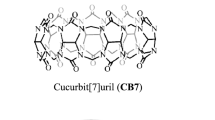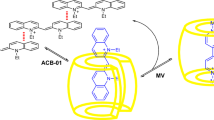Abstract
Improvements in optical properties of organic xanthene fluorophores through molecular encapsulation in cucurbit[7]uril (CB7) should enable better molecular probes and devices to be designed. Although the interactions of several dyes with CB7 have been studied, the data have often been incomplete. Uniformly applied ensemble spectroscopic studies are presented herein, including 1H NMR, UV–Vis, and fluorescence titration experiments of aqueous CB7 complexes with the monocationic xanthene dyes rhodamine 6G (Rh6G, 1), rhodamine B (RhB, 2), rhodamine B benzyl ester (RhBBE, 3), pyronin B (PyB, 4) and pyronin Y (PyY, 5). All of these cationic xanthene dyes formed 1:1 complexes with cucurbit[7]uril as evidenced by NMR data and Job’s plots of fluorescence changes upon addition of CB7. Non-linear regression analysis of the fluorescence titration curves gave precise Ka’s for RhB, RhBBE and PyB between 1.1 × 105 M−1 and 9.1 × 106 M−1. The fluorescence emission intensity of Rh6G was lowered 0.8-fold in the presence of CB7 while the other dyes examined showed an increase between 1.3 and 4.7-fold. NMR titration experiments from 0 to 2.0 equivalents of CB7 per equivalent of xanthene gave in only some cases very clear evidence of inclusion complexation. Non-specific adsorption of these xanthene dyes onto borosilicate glass was very pronounced and could be inhibited by dye inclusion into CB7.
Graphical Abstract
Pyronin B-Cucurbit[7]uril complex















Similar content being viewed by others
References
Aslan, K., Gryczynski, I., Malicka, J., Matveeva, E., Lakowicz, J.R., Geddes, C.D.: Metal-enhanced fluorescence: an emerging tool in biotechnology. Curr. Opin. Biotechnol. 16, 55–62 (2005)
Dooley, C.T., Dore, T.M., Hansom, G.T., Jackson, W.C., Remington, S.J., Tsien, R.Y.: Imaging dynamic redox changes in mammalian cells with green fluorescent protein indicators. J. Biol. Chem. 279, 22284–22293 (2004)
Kettling, U., Koltermann, A., Schwille, P., Eigen, M.: Real-time enzyme kinetics monitored by dual-color fluorescence cross-correlation spectroscopy. Proc. Natl. Acad. Sci. USA. 95, 1416–1420 (1998)
Yan, P., Holman, M.W., Robustelli, P., Chowdhury, A., Ishak, F.I., Adams, D.M.: Molecular switch based on a biologically important redox reaction. J. Phys. Chem. B 109, 130–137 (2005)
Zhang, Y.B., Kanungo, M., Ho, A.J., Freimuth, P., van der Lelie, D., Chen, M., Khamis, S.M., Datta, S.S., Johnson, A.T.C., Misewich, J.A., Wong, S.S.: Functionalized carbon nanotubes for detecting viral proteins. Nano Lett. 7, 3086–3091 (2007)
Palacios, R.E., Fan, F.-R.F., Bard, A.J., Barbara, P.F.: Single-molecule spectroelectrochemistry (SMS-EC). J. Am. Chem. Soc. 128, 9028–9029 (2006)
Fabbrizzi, L., Poggi, A.: Sensors and switches from supramolecular chemistry. Chem. Soc. Rev. 25, 197–202 (1995)
Arunkumar, E., Forbes, C.C., Smith, B.D.: Improving the properties of organic dyes by molecular encapsulation. Eur. J. Org. Chem. 2005, 4051–4059 (2005)
Mohanty, J., Bhasikuttan, A.C., Nau, W.M., Pal, H.: Host-guest complexation of neutral red with macrocyclic host molecules: contrasting pK(sub a) shifts and binding affinities for cucurbit[7]uril and b-cyclodextrin. J. Phys. Chem. B 110, 5132–5138 (2006)
Rohatgi, K.K., Singhal, G.S.: Nature of bonding in dye aggregates. J. Phys. Chem. 70, 1695–1701 (1966)
Selwyn, J.E., Steinfeld, J.I.: Aggregation equilibria of xanthene dyes. J. Phys. Chem. 76, 762–774 (1972)
Vosch, T., Hofkens, J., Cotlet, M., Köhn, F., Fujiwara, H., Gronheid, R., van der Biest, K., Weil, T., Herrmann, A., Müllen, K., Mukamel, S., van der Auweraer, M., de Schryver, F.C.: Influence of structural and rotational isomerism on the triplet blinking of individual dendrimer molecules. Angew. Chem. Int. Ed 40, 4643–4648 (2001)
Tinnefeld, P., Buschmann, V., Weston, K.D., Sauer, M.: Direct observation of collective blinking and energy transfer in a bichromophoric system. J. Phys. Chem. A 107, 323–327 (2003)
Lee, T.-H., Gonzalez, J.I., Zheng, J., Dickson, R.M.: Single molecule optoelectronics. Acc. Chem. Res. 38, 534–541 (2005)
Nau, W.M., Mohanty, J.: Taming fluorescent dyes with cucurbit[7]uril. Inter. J. Photoenergy 7, 717–726 (2005)
Mohanty, J., Nau, W.M.: Ultrastable rhodamine with cucurbituril. Angew. Chem. Int. Ed 44, 3750–3754 (2005)
Buschmann, H.-J., Schollmeyer, E.: Stabilization of dyes against hydrolytic decomposition by the formation of inclusion compounds. J. Incl. Phenom. Macro. Chem. 7, 133–141 (1992)
Freeman, W.A., Mock, W.L., Shih, N.Y.: Cucurbituril. J. Am. Chem. Soc. 103, 7367–7368 (1981)
Day, A., Arnold, A.P., Blanch, R.J., Snushall, B.: Controlling factors in the synthesis of cucurbituril and its homologues. J. Org. Chem. 66, 8094–8100 (2001)
Kim, J., Jung, I., Kim, S., Lee, E., Kang, J., Sakamoto, S., Yamaguchi, K., Kim, K.: New cucurbituril homologues: synthesis, isolation characterization and X-ray crystal structures of cucurbit[n]uril (n = 5, 7 and 8). J. Am. Chem. Soc. 122, 540–541 (2000)
Lagona, J., Mukhopadhyay, P., Chakrabarti, S., Isaacs, L.: The cucurbit[n]uril family. Angew. Chem. Int. Ed 44, 4844–4870 (2005)
Saleh, N., Al-Rawashdeh, N.A.F.: Fluorescence enhancement of cabendazim fungicide in cucurbit[6]uril. J. Fluoresc. 16, 487–493 (2006)
Maafi, M., Laassis, B., Aaron, J.-J.: Photochemically induced fluorescence investigation of b-cyclodextrin; azure A inclusion complex and determination of analytical parameters. J. Incl. Phenom. Macro. Chem. 22, 235–247 (1995)
Singh, M.K., Pal, H., Koti, A.S.R., Sapre, A.V.: Photophysical properties and rotational relaxation dynamics of neutral red bound to b-cyclodextrin. J. Phys. Chem. A 108, 1465–1474 (2004)
Schiller, R.L., Lincoln, S.F., Coates, J.H.: The inclusion of pyronine Y by b- and g-cyclodextrin. J. Chem. Soc. Faraday Trans. 83, 3237–3248 (1987)
Reija, B., Al-Soufi, W., Novo, M., Tato, J.V.: Specific interactions in the inclusion complexes of pyronines Y and B with b-cyclodextrin. J. Phys. Chem. B 109, 1364–1370 (2005)
Wang, R., Yuan, L., Macartney, D.H.: A green to blue fluorescence switch of protonated 2-aminoanthracene upon inclusion in cucurbit[7]uril. Chem. Commun. 5867–5869 (2005)
Wagner, B.D., Stojanovic, N., Day, A.I., Blanch, R.J.: Host properties of cucurbit[7]uril: fluorescence enhancement of anilinonaphthalene sulfonates. J. Phys. Chem. B 107, 10741–10746 (2003)
Mohanty, J., Pal, H., Ray, A.K., Kumar, S., Nau, W.M.: Supramolecular dye laser with cucurbit[7]uril in water. Chem. Phys. Chem. 8, 54–56 (2007)
Martyn, T.A., Moore, J.L., Halterman, R.L., Yip, W.T.: Cucurbit[7]uril induces superior probe performance for single-molecule detection. J. Am. Chem. Soc. 129, 10338–10339 (2007)
Halterman, R.L., Moore, J.L., Mannel, L.M.: Disrupting aggregation of tethered rhodamine B dyads through inclusion in cucurbit[7]uril. J. Org. Chem. 73, 3266–3269 (2008)
Ingham, K.C.: On the application of job’s method of continuous variation to the stoichiometry of protein-ligand complexes. Anal. Biochem. 68, 660–663 (1975)
Likussar, W., Boltz, D.F.: Theory of continuous variations plots and a new method for spectrophotometric determination of extraction and formation constants. Anal. Chem. 43, 1265–1271 (1971)
Ong, W., Gomez-Kaifer, M., Kaifer, A.E.: Cucurbit[7]uril: a very effective host for viologens and their cation radicals. Org. Lett. 4, 1791–1794 (2002)
Gutierrez, M.C., Hortiguela, M.J., Ferrer, M.L., delMonte, F.: Highly fluorescent rhodamine B nanoparticles entrapped in hybrid glasses. Langmuir 23, 2175–2179 (2007)
Klika, Z., Weissmannova, H., Capkova, P., Pospisil, M.: The rhodamine B intercalation of montmorillonite. J. Coll. Interface Sci. 275, 243–250 (2004)
Hassner, A., Alexanian, V.: Direct room temperature esterification of carboxylic acids. Tetrahedron Lett. 46, 4475–4478 (1978)
Acknowledgements
Support through NSF (DMR-0805233) and from the University of Oklahoma and Oklahoma State Regents for Higher Education is appreciated. JLM acknowledges the DOEd for a GAANN Fellowship. KY, JAIH, KAW acknowledge support through the Undergraduate Research Program.
Author information
Authors and Affiliations
Corresponding author
Electronic supplementary material
Below is the link to the electronic supplementary material. General experimental procedures and NMR spectral data for RhBBE 3. UV/Vis absorption spectra, fluorescent emission spectra, Job’s plots, titration curves of changes in fluorescence with added CB7 and non-linear regression analysis to give Ka’s, NMR titration spectra of xanthenes 1–5 in presence of varying amounts of CB7. Absorption and emission spectra of PyY (5)–CB7 mixtures after storage in borosilicate, polypropylene or polystyrene containers.




Rights and permissions
About this article
Cite this article
Halterman, R.L., Moore, J.L., Yakshe, K.A. et al. Inclusion complexes of cationic xanthene dyes in cucurbit[7]uril. J Incl Phenom Macrocycl Chem 66, 231–241 (2010). https://doi.org/10.1007/s10847-009-9615-9
Received:
Accepted:
Published:
Issue Date:
DOI: https://doi.org/10.1007/s10847-009-9615-9




